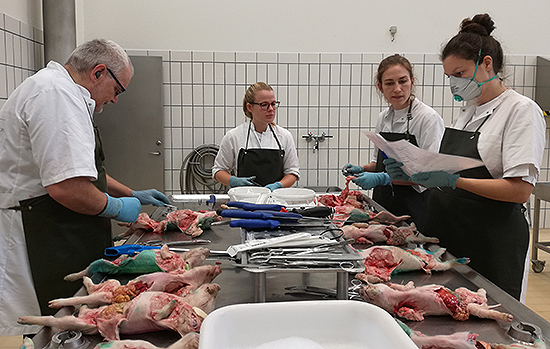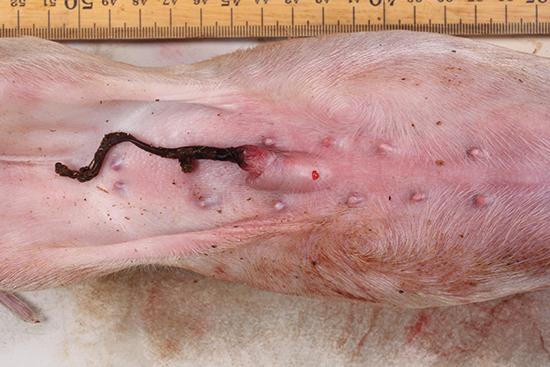Pathogenesis, diagnosis and pathology: The veterinary pathology group
 The purpose is to improve human and animal health through comparative pathological studies. Focus is especially on infectious diseases, where spontaneous infections in e.g. poultry, pigs and cattle are analysed together with diseases in various experimental animal models. The research contributes to evidence based solutions of actual health challenges associated with especially bacterial, viral and fungal infections. In all studies, application of different in situ methods, both simple and complex infection biology interactions are clarified with respect to the inflammatory response and the host-pathogen interaction.
The purpose is to improve human and animal health through comparative pathological studies. Focus is especially on infectious diseases, where spontaneous infections in e.g. poultry, pigs and cattle are analysed together with diseases in various experimental animal models. The research contributes to evidence based solutions of actual health challenges associated with especially bacterial, viral and fungal infections. In all studies, application of different in situ methods, both simple and complex infection biology interactions are clarified with respect to the inflammatory response and the host-pathogen interaction.

- In situ investigation of potential infectious causes of post-weaning diarrhea in pigs:
Enterotoxigenic Escherichia coli (ETEC) is thought to be the main cause of post-weaning diarrhea in pigs. However, ETEC is often not demonstrated in symptomatic pigs, which indicates that there are other causative agents. These potential etiologies might not require antimicrobials. It is important to clarify the causes of disease to avoid unnecessary treatment with antimicrobials. Prudent use of antimicrobials is imperative to prevent antimicrobial resistance.
The aim is to evaluate lesions of the intestines, and elucidate (potential) causative pathogens of post-weaning diarrhea in pigs. Histological sections from the jejunum, ileum and colon of the pigs are evaluated. Furthermore, immunohistochemistry and in situ hybridization will be used to identify/localize different pathogens in the tissues. - In situ investigation of the disease dynamics of omphalitis in pigs:
It is estimated that approximately 90 to 95 % of pigs in conventional herds are treated with antimicrobials. Treatment is often initiated in order to treat omphalitis and prevent various sequelae caused by bacteria like, e.g. umbilical herniation, sepsis, meningitis and arthritis. It is important to clarify the presence and causes of lesions to avoid unnecessary treatment with antimicrobials. Prudent use of antimicrobials is imperative to prevent antimicrobial resistance.
The aim of this study is to evaluate lesions in the umbilical area, and elucidate (potential) causative pathogens, and derived lesions of omphalitis in pigs. Histological sections from the umbilical area, meninges, and the synovial membrane from the left elbow joint of the pigs are evaluated. Furthermore, immunohistochemistry and in situ hybridization will be used to identify/localize different pathogens in the tissues. - Forensic evaluation of the timing of granulation tissue in pigs:
In the project four specific objectives are addressed:
1. Obtain novel parameters for age assessment of granulation tissue based on stem cells.
2. Discover proteins and mRNA expression signatures for age assessment of granulation tissue
3.Develop an AI image analysis algorithm able to assess changes in granulation tissue over time.
4. Create a mathematical model for objective age assessment of granulation tissue.
- Barington K, Skovgaard K, Henriksen NL, et al: Histological evaluation of experimental porcine bruises.
J Forensic Legal Med, 58, 2018, 1166-1176.
The standardized technique for evaluation of porcine bruices was established. - In poultry, Escherichia coli is a common cause of high-cost infections. Consequently, autogenous vaccines are often used despite limited and conflicting evidence on their effectiveness have been presented. The present study aimed to investigate the efficacy of a commonly used autogenous vaccine, previously deemed ineffective, in an aerosol model of colibacillosis. Methods: Broiler breeders (n = 47) were randomly allocated to one of four groups (vaccinated and unvaccinated birds receiving an autogenous vaccine or sterile saline intramuscularly) and challenged with either aerosolised E. coli or vehicle at 29 weeks of age. Two days following inoculation, the birds were euthanised, thoroughly necropsied, and samples for bacteriology and histopathology were collected. Results: Vaccinated birds had a significantly lower bacteriology score compared to the unvaccinated group challenged with E. coli (p < 0.01) and a lower overall air sac lesion score (p < 0.05). Overall lung and spleen lesion scores only differed significantly between the unvaccinated E. coli challenged group compared to the vehicle inoculated groups. The overall gross pathology score was 2.8 and 1.95 in the unvaccinated and vaccinated E. coli challenge groups, respectively, whereas the vaccinated vehicle group had a score of 0.9 and the unvaccinated vehicle group a score of 1. Conclusions: A protective effect of an autogenous vaccine was found utilising an aerogenous model of colibacillosis through multiple methods of evaluation. The findings encourage the continued use of autogenous vaccines and underlines the necessity of discriminative experimental models with high predictive validity when evaluating vaccine.
Kromann, Sofie, Olsen, Rikke Heidemann, Bojesen, Anders Miki, Jensen, Henrik Elvang & Thoefner, Ida. 2021. Protective potential of an autogenous vaccine in an aerogenous model of Escherichia coli infection in broiler breeders I: Vaccines. 9, 11, 1233 - Cornely, O. A., Alastruey-Izquierdo, A., Arenz, D., Chen, S. C. A., Dannaoui, E., Hochhegger, B., Hoenigl, M., Jensen, Henrik Elvang, Lagrou, K., Lewis, R. E., Mellinghoff, S. C., Mer, M., Pana, Z. D., Seidel, D., Sheppard, D. C., Wahba, R., Akova, M., Alanio, A., Al-Hatmi, A. M. S., Arikan-Akdagli, S., Badali, H., Ben-Ami, R., Bonifaz, A., Bretagne, S., Castagnola, E., Chayakulkeeree, M., Colombo, A. L., Corzo-León, D. E., Drgona, L., Groll, A. H., Guinea, J., Heussel, C., Ibrahim, A. S., Kanj, S. S., Klimko, N., Lackner, M., Lamoth, F., Lanternier, F., Lass-Floerl, C., Lee, D., Lehrnbecher, T., Lmimouni, B. E., Mares, M., Maschmeyer, G., Meis, J. F., Meletiadis, J., Morrissey, C. O., Nucci, M., Oladele, R., Pagano, L. Mucormycosis ECMM MSG Global Guideline Writing Group, M. E. M. G. G. W. G., 2019, I: Lancet Infectious Diseases. 19, 12, s. e405-e421
- Hovmand-Hansen, Trine, Jensen, T. B., Vestergaard, K., Nielsen, M. B. F., Leifsson, Páll S. & Jensen, Henrik Elvang. 2021. Early risk factors, development, disappearance and contents of umbilical outpouching in Danish pigs I: Livestock Science. 251, 104654.
Svineafgiftsfonden: Diagnostik og konsekvens ved navlehævelser hos svin
Contact: Henrik Elvang Jensen
Halelæsioner hos malkekøer
Contact: Henrik Elvang Jensen
Traumatic lesions in veterinary and human forensic medicine - development and validation of porcine models
Contact: Kristiane Barington and Henrik Elvang Jensen
Characterization of murine experimental models of mycoses
Contact: Henrik Elvang Jensen
Colibacillosis in poultry – infection model development, characterization and application, and diagnostics, pathology, and genomic characterization of E. coli from Danish broiler breeder and broiler
Contact: Sofie Kromann and Henrik Elvang Jensen
One World- One Guideline for diagnosis of candidosis.
Contact: Henrik Elvang Jensen
One World- One Guideline for diagnosis of aspergillosis.
Contact: Henrik Elvang Jensen
Influenza in pigs - development of human models.
Contact: Charlotte Kristensen, Lars E. Larsen and Henrik Elvang Jensen
- Halesår hos malkekøer. Veterinært kandidatspeciale - Cecilie Kirstine Nielsen, Ditte Marie Schjermer og Natascha Schou Jensen
In the past 5-years, the research has been funded by the EU commission under the research programme Horizon 2020 and the Independent Research Fund Denmark.
Contact address
Ridebanevej 3
1870 Frederiksberg C
Phone +45 35 33 31 00
Group members
| Name | Title | Phone | |
|---|---|---|---|
| Andersen, Betina Gjedsted | Biomedical Laboratory Scientist | +4535336737 | |
| Andersen, Frederik | Attendant FU | +4535336735 | |
| Barington, Kristiane | Associate Professor | +4535333112 | |
| Becker, Cecilie Brandt | PhD Fellow | +4535337580 | |
| Birk, Amanda Øpstun | Research Assistant | +4535335431 | |
| Blirup-Plum, Sophie Amalie | Assistant Professor | +4535331513 | |
| Brok, Dennis | Attendant FU | +4535333101 | |
| Bækgård, Cecilie | PhD Fellow | +4535326909 | |
| Flyger, Christoffer Kirkelund | PhD Fellow | ||
| Hansen, Mette Sif | Associate Professor | +4535326468 | |
| Hansen, Vibeke Bøgelund | Attendant | ||
| Harpf, Verena Elke | Postdoc | +4535332315 | |
| Hydeskov, Helle Bernstorf | Assistant Professor | +4535328601 | |
| Jensen, Jan Lykke | Attendant | ||
| Jensen, Henrik Elvang | Professor | +4535333100 | |
| Kristensen, Charlotte | Postdoc | +4535325008 | |
| Kromann, Sofie | Assistant Professor - Tenure Track | +4535326918 | |
| Leifsson, Páll Skúli | Associate Professor | +4535333114 | |
| Lübbers, Nanna Sand | Research Assistant | +4535337667 | |
| Petersen, Elisabeth Wairimu | Laboratory Technician | +4535336757 |

